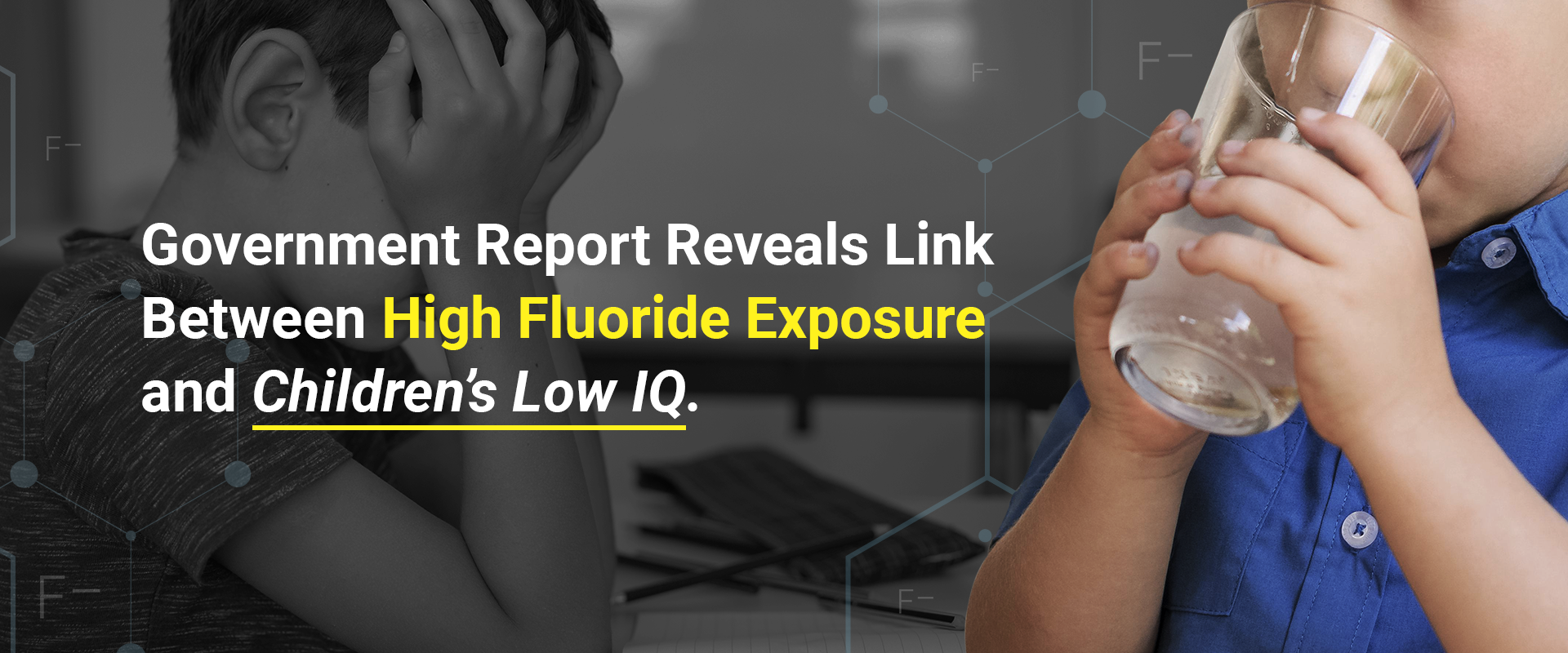Posted by Dr. Roy M. Speiser, V.P., CWR, Environmental on Sep 5th 2024
Government Report Reveals Link Between High Fluoride Exposure and Children’s Low IQ

In the United States, roughly 3 million people might drink water with high fluoride levels.
A National Toxicology Program (NTP) report states that high levels of fluoride in children are "consistently associated" with lower IQs and other neurodevelopmental problems.
In 2016, the NTP started to verify the links between fluoride and cognition through a systematic review of scientific literature. 72 studies reviewed the outcome of fluoride exposure on Children’s IQ and intelligence. 64 studies identified that fluoride exposure was related to IQ, meaning that higher fluoride exposure was associated with lower IQs and vice versa.
The report stated that "higher approximate fluoride exposures are consistently associated with lower child IQ."
The National Toxicology Program is an aspect of the Department of Health and Human Services.
Drinking water with fluoride levels surpassing the World Health Organization's 1.5 mg/L restrain was identified as high exposure by the NTP.
The admissible limits are different in the United States. The Food and Drug Administration set a borderline of 0.7 mg/L for fluoride presence in drinking water (including naturally occurring and added fluoride, or fluoridation), while the Environmental Protection Agency has 2 mg/L.
The NTP states that 0.59 percent of the United States population, or about 1.9 million people, obtained water containing 1.5 mg/L or more naturally occurring fluoride by April 2020. A total of 1 million people were provided with water containing 2 mg/L or more of naturally occurring fluoride.
Fluoride exposure is associated with other neurodevelopmental and cognitive effects in children; however, with outcomes being heterogeneous, there is limited confidence in the literature for these effects.
In the report, IQ studies were reviewed in 10 countries, including Canada and Mexico. The United States was not represented.
The United States commenced a community water fluoridation program in 1945, which is regarded as a triumphant public health project. Fluoride avoids and restores damage to teeth caused by bacteria.
As a result, the NTP conducted the current study because there were concerns that children and pregnant women may ingest fluoride in excess amounts due to exposure to the mineral from water, beverages, toothpaste, and tea.
Fluoride Discussion
In May, the NTP reported that prenatal fluoride exposure was associated with "neurobehavioral problems" among Los Angeles mother-child pairs.
According to Ashley Malin, lead investigator of the study, fluoride consumption during pregnancy may negatively affect fetal brain development. Fluoride consumption is not known to benefit fetuses, she said.
“Based on their mother’s reports, we found that each 0.68 milligram per liter increase in fluoride levels in pregnant women’s urine was associated with nearly twice the odds of children scoring in the borderline clinical range for neurobehavioral problems by age three,” she said.
An American Dental Association (ADA) statement on May 22 stated the study was not "nationally representative" and didn't measure "actual consumption of fluoridated water."
According to the group, the JAMA study is exploratory. The ADA has yet to see peer-reviewed research that would modify its long-standing recommendation for the public to brush twice a day with fluoride toothpaste and drink optimally fluoridated water.
Research and practical experience have shown that community water fluoridation reduce cavities by 25 percent in children and adults.
To evade dental cavities, the report promoted community water fluoridation as a "risk-free, beneficial, and cost-effective" procedure.
When parents used toothpaste for children younger than 24 months, the fluoride dose was 5.9 to 7.2 times higher than recommended, based on another study from January.
MetalGon Filter Technology
CWR has unveiled a groundbreaking advancement in water purification with its MetalGon Filter technology, specifically engineered to combat all forms of fluoride contamination. The newly launched AIO Ultra Ceramic Water Filter, when paired with the Pure Metalgon system, creates an unparalleled filtration unit that effectively targets and eliminates harmful substances such as chloramine, chlorine, pharmaceuticals, trihalomethanes (THMs), haloacetic acids (HAAs), and a wide spectrum of heavy metals—essential for regions grappling with high concentrations of these pollutants.
This revolutionary technology represents a significant leap forward in ensuring safe drinking water; the Ultra-Ceramic filter excels at diminishing undesirable tastes and odors while significantly reducing turbidity alongside contaminants like lead and THMs. Meanwhile, the Pure Metalgon Filter operates diligently to eradicate toxic chemicals like fluoride to near non-detectable levels along with various heavy metals including aluminum, cadmium, iron, manganese, mercury, nickel, silver, and zinc.

